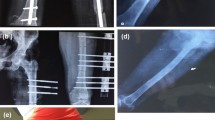Abstract
Background
Infected nonunion encompasses a series of complex problems including osteomyelitis, bone and soft tissue loss, osteopenia, adjacent joint stiffness, complex deformities, limb length discrepancies, and multidrug resistant multibacterial infections. Several surgical techniques were proposed for management of this major complication including intramedullary devices, free tissue transfer and in situ reconstruction, and the Ilizarov technique.
Aim of the study
The aim of this study was to revaluate the results of management of infected non-united fractures of the femur in adults using the Ilizarov frame.
Patients and methods
There were 20 patients with infected femoral nonunion, whom were managed using Ilizarov technique. The mean age of the studied patients was 37.45 years. There was only one female. Of the included patients, ten had diaphyseal fractures, two suffered from proximal metaphyseal fractures, and eight presented with distal metaphyseal nonunion. No patient was able to bear weight on the infected limb. All the patients had had previous surgeries, with a mean of 1.95 (SD 1.050 and range 1–5 previous surgeries). Debridement of the infected bone and soft tissues was performed in all the studied cases. Techniques adopted were acute compression in 5 patients, acute shortening in 13, and acute shortening and distant corticotomy in 2 patients: one proximal and one distal corticotomies. Periodic regular clinical, as well as radiographic, evaluation was performed. A minimum follow-up period of 2 years was an inclusion criterion in this study.
Results
The bone, (radiological) results, functional results, and complications were evaluated. The mean time between injury and the application of the frame was 10.15 (SD 8.798, range 3–35 months). The mean follow-up period was 36.65 (SD 15.849, range 25–82 months). The mean external fixation time was 8.03 (SD 2.774, range 5–15 months). The mean limb length discrepancy was 1.45 (SD 1.134, range 0–3 cm). Bony union was achieved in all except two patients. One patient had refractured 1 month after frame removal and union was managed by reapplication of the frame. Bone grafting was not performed in this study. Infection was controlled in all but one patient, in which the fracture did not unite. The radiological results were excellent in ten patients (50 %), good in six (30 %), fair in one (5 %), and poor in three patients (15 %). The functional results were excellent in 4 patients (20 %), good in 13 (65 %), and poor in 3 patients (15 %) and no fair results. In the studied 20 patients, there were 63 complications in total, (25 problems, 6 obstacles, and 32 true complications). From the encountered 32 true complications, 4 were defined as minor and 28 were considered as major complications.
Conclusion
Despite the high rate of complications, the Ilizarov technique was found to be effective in the treatment of infected femoral nonunion as it allowed simultaneous treatment of bone loss, nonunion, infection, shortening, and deformity.


Similar content being viewed by others
References
Gustilo RB, Anderson JT (1976) Prevention of infection in the treatment of 1,025 open fractures of long bones: retrospective and prospective analyses. J Bone Joint Surg Am 58-A:453–458
Dendrinos GK, Kontos S, Lyritsis E (1995) Use of the Ilizarov technique for treatment of non-union of the tibia associated with infection. J Bone Joint Surg Am 77:835–846
Maiocchi AB, Aronson J (1991) Association for the study and application of the method of Ilizarov group: nonunion of the femur. In Operative Principles of Ilizarov. In: Fracture Treatment, Nonunion, Osteomyelitis, Lengthening, Deformity Correction. Williams and Wilkins, Baltimore, pp 245–262
Paley D (1990) Problems, obstacles, and complications of limb lengthening by the Ilizarov technique. Clin Orthop Relat Res 250:81–104
Motsitsi NS (2008) Management of infected nonunion of long bones: the last decade (1996) injury. Int J Care Injured 39:155–160
Zhang X, Liu T, Li Z, Peng W (2007) Reconstruction with callus distraction for nonunion with bone loss and leg shortening caused by suppurative osteomyelitis of the femur. J Bone Joint Surg [Br] 89-B:1509–1514
Tsuchiya H, Tomita K (2003) Distraction osteogenesis for treatment of bone loss in the lower extremity. J Orthop Sci 8:116–124
Blum, Bongiovanni JC, Morgan SJ, Flierl MA, Baldy dos Reis F (2010) Complications associated with distraction osteogenesis for infected nonunion of the femoral shaft in the presence of a bone defect. J Bone Joint Surg [Br] 92-B:565–570
Krishnan A, Pamecha C, Patwa JJ, Sever JW (2006) Modified Ilizarov technique for infected non-union of the femur: the principle of distraction–compression ontogenesis. J Orthop Surg 14(3):265–272
Conflict of interest
The authors declare that they have no conflict of interest.
Author information
Authors and Affiliations
Corresponding author
Rights and permissions
About this article
Cite this article
El-Sayed, M.M.H., Gaballah, S., Hosny, G. et al. Management of infected nonunion of the femur in adults using the Ilizarov technique. Eur Orthop Traumatol 5, 285–291 (2014). https://doi.org/10.1007/s12570-013-0235-x
Received:
Accepted:
Published:
Issue Date:
DOI: https://doi.org/10.1007/s12570-013-0235-x




